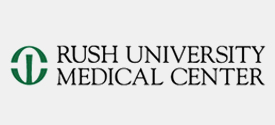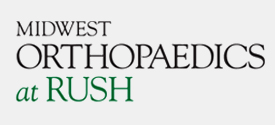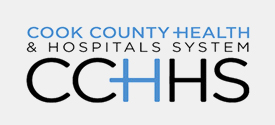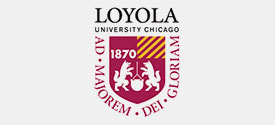About the Program
Program Highlights
Ranked among the very best orthopaedic programs in the country by U.S. News & World Report, Rush University Medical Center in Chicago is home to nationally respected orthopaedic surgeons who find great reward in the fact that their research, discoveries and leading-edge therapies benefit patients today not decades from now. Specific program highlights include:
- Dr. Joshua Jacobs (chairman) – President of AAOS
- #5 ranked program nationally (U.S. News & World Report)
- #1 ranked program in Illinois (U.S. News & World Report)
- Team physicians for the Chicago White Sox
- Team physicians for the Chicago Bulls
- Team physicians for DePaul University Athletics
- Numerous specialty society leadership roles
- Countless textbook and journal editorialships
- Numerous publications in a variety of subspecialties
- See Research Section for a list of our most recent publications
Orthopaedic Transformation

Rush has recently undergone a major transformation. The new orthopaedic building is complete. The new orthopaedic center is a 220,000-square-foot building, and is the largest orthopaedic medical office building in Illinois.
The building houses:
- Outpatient clinic space
- Offices for orthopaedic surgeons and staff
- A clinical research center
- Diagnostic imaging
- Gait laboratory
- Orthopaedic resident facilities
- Orthopaedic Biomechanics Lab
- Implant Recovery Lab
- Hard Tissue Histology Lab
Upcoming Events
Grand Rounds
Wednesday, October 6, 2021
“MIS in deformity and Outreach”
Gregory M. Mundis Jr., M.D.
Director San Diego Spine Fellowship
CEO Global Spine Outreach
Pediatric and Adult Spinal Deformity Surgery
Scripps Clinic Medical Group Department of Orthopedics
Wednesday, October 13, 2021
Dr. Matthew P., Abdel M.D.
Andrew A. and Mary S. Professor of Orthopedic Surgery
Mayo Clinic College of Medicine
Mission And Goals
The mission and goals of the department are to provide patients with the highest quality of orthopaedic care in both inpatient and outpatient settings; to conduct world class research in the pathogenesis and treatment of musculoskeletal diseases; and to train the next generation of orthopaedic surgeons and researchers to lead the profession in the provision of the highest quality orthopaedic care. These missions and goals will be achieved by:
- Providing an optimal training environment whereby clinical care is carefully balanced with post-graduate medical education
- Maintaining the highest standards of clinical practice and patient satisfaction
- Stressing the importance of research and continuing education for department members
- Increasing the department members’ awareness of the changing health care climate and the impact of such change on the practice of medicine.
The Department of Orthopaedic Surgery, chaired by Joshua J. Jacobs, MD, offers a five-year residency program accredited by the Orthopaedic Residency Review Committee of the Accreditation Council of Graduate Medical Education (ACGME). Five positions are available each year beginning at Post-graduate Level 1. For those who have completed a residency in orthopaedic surgery and are seeking specialized training, one-year fellowships are available in adult reconstruction, spinal surgery, sports medicine and orthopaedic research. The department adheres to the goals and objectives of The American Board of Orthopaedic Surgery and the ACGME.
The department is committed to developing and maintaining ongoing, innovative clinical and basic scientific research. New approaches to clinical problems will improve health outcomes for orthopaedic patients, while advancing the department’s contribution to excellence in research.
The PGY-1 is now spent within the Department of Orthopaedics and involves the equivalent of one month of skills training throughout this first year. PGY-1 rotations include adult reconstruction, hand, ortho trauma, emergency room, rheumatology, musculoskeletal radiology, general surgery and general surgery trauma.
The PGY-2 through PGY-5 years are spent in the orthopaedic department. The majority of the residency is spent at Rush University Medical Center. However, residents also rotate at:
- Cook County – John H. Stroger Hospital
- Excellent trauma experience with fellowship trained traumatologists
- Rockford Memorial Hospital and St. Anthony Hospital, Rockford, Ill.
- Extensive trauma exposure
- Ann & Robert H. Lurie Children’s Hospital of Chicago
- Broad spectrum of pediatric care
Residents gain substantial experience in the diagnosis, management and treatment of all orthopaedic problems, and are well prepared to enter into private practice or academics. Rush is a prolific orthopaedic department and the training program continually benefits from the number of cases completed each year (2008 numbers are listed below). The majority of residents choose to pursue subspecialty fellowship training and the reputations of each department at Rush provides ample opportunity to train at the top fellowship programs. The program is demanding, stimulating, and rewarding. It develops top-notch orthopaedic surgeons and fosters a lasting camaraderie between the residents and attending staff.
Please visit the Academics Section for more specific information regarding program structure, objectives and resident rotations/schedules.
Surgical Case Volume at Rush for 2008 by Section:
| Section | Total Cases 2008 |
| Reconstruction | 2516 |
| Foot | 608 |
| Hand | 1165 |
| Sports | 2851 |
| Pediatrics | 127 |
| Trauma/Oncology | 706 |
| Spine | 1043 |
| Trauma – Rockford | 900 |
| Trauma – Cook County | 700 |
Departments
The orthopaedic department is organized into sections or services which represent the major subspecialties of the discipline. There are over 29 faculty members that provide cases and contribute to the overall education of the residents. Each specialty features leaders in their field and well-known experts. The residency program significantly benefits from the depth of knowledge and experience that exists within each department.
Section Of Adult Reconstruction
The adult reconstruction service is dedicated to the care of inflammatory, degenerative and post-traumatic arthritic disorders of the major joints of the lower extremity. It is a particularly active clinical service that has seven full-time attendings.
Rush is a tertiary referral center for many complicated lower extremity reconstruction problems. In addition, a high volume of primary total-hip and total-knee arthroplasties are performed at Rush. The resident is actively involved in preoperative management of these patients and obtains considerable experience in the operative management of these disorders.
Residents on the service also rotate through the offices of the joint replacement attendings. Complementing the clinical service is a large full-time staff dedicated to the maintenance of a clinical database in which all joint-replacement patients are followed in a prospective fashion. Many residents participate in clinical research projects that utilize this extensive database.
A large portion of the research efforts of the Department of Orthopaedic Surgery are dedicated to joint-replacement surgery, with subsections in biomechanics, biomaterials and molecular and cell biology. The adult reconstruction service represents one of the preeminent programs in the Midwest and the nation.
Section Of Pediatric Orthopaedics
The pediatric orthopaedic program offers a broad inpatient and outpatient experience in all musculoskeletal diseases of childhood. The service manages a wide variety of congenital, metabolic endocrinologic and traumatic disorders through inpatient consultations, clinic referrals and emergency room admissions. Residents are involved in all aspects of patient care from diagnosis to operative intervention. The service also performs reconstruction surgery in young adults with continuing pediatric problems, including various types of osteotomy. The Ilizarov apparatus is also commonly used for leg-length discrepancies, bone defects and angular deformities.
Fourth-year residents spend five months in a pediatric orthopaedic rotation at Shriners Hospital for Children, Chicago
Section Of Orthopaedic Oncology
The Section of Orthopaedic Oncology is responsible for the diagnosis and treatment of musculoskeletal neoplasms, which include soft-tissue tumors, primarily of the extremities and primary bone tumors. The section sees approximately 300 new tumor patients per year.
The management of primary bone and soft-tissue tumors emphasizes the concepts of limb salvage. The approach is to remove the neoplasm and reconstruct the limb to provide return of function. Limb salvage requires extensive knowledge and experience in bone transplantation, prosthetic replacement and tumor biology.
In addition to the clinical care of patients with musculoskeletal tumors, the section has developed a broad-based research program. Clinical research is being performed in tumor biology and diagnosis. Basic science research is being done in the area of tumor biology, using tissue-culture methodology and animal models.
The section is comprised of two orthopaedic attending surgeons and an orthopaedic oncology nurse clinician. Residents and medical students rotate throughout the service on a regular basis. A biweekly sarcoma management conference is also held.
The mission of the Section of Sports Medicine is to achieve regional and national recognition and leadership in the care of athletes at all levels of skill, in all sports and of all ages. Patient care, clinical and basic science research, and resident and fellow education comprise the foundation of the program.
Clinical problems are cared for by full-time orthopaedic sports medicine surgeons, orthopaedic fellows, primary care sports medicine fellows, nurse clinicians and certified athletic trainers. The major clinical problems encountered in our office practices include:
- Meniscal tears
- Anterior cruciate ligament (ACL) and other ligament injuries
- Patellofemoral disorders
- Shoulder instability
- Impingement syndrome
- Rotator cuff disorders
- Shoulder arthritis
- Articular cartilage disorders
Stress fractures, overuse syndromes, foot and ankle pathology, and athletic trauma (fractures) are also treated. Our full-time orthopedists have over 6,000 office visits annually, and they perform more than 600 surgical cases yearly. State-of-the-art arthroscopic knee ligament cartilage transplant and shoulder reconstruction procedures are performed by members of the staff, who emphasize current principles of nonsurgical and post-surgical rehabilitation.
The section holds a weekly sports medicine conference for residents and fellows, along with a weekly reading club. The section also conducts continuing education sports medicine courses for primary care physicians, physical therapists and athletic trainers, and holds arthroscopy workshops. Rotations for visiting international fellows, visiting residents and medical students are available. Residents and fellows have the opportunity to provide event coverage for local high school and club sports, thus expanding their educational experience as well as providing much-needed preventive medicine.
Clinical research among knee and shoulder surgery patients is being conducted. Use of the KT1000 arthrometer to objectify pre- and postreconstruction knee laxity indices continues to be investigated. Biomechanical gait analysis studies are being conducted on ACL deficient and ACL reconstructed patients. Studies of keratin sulfate proteoglycan correlated with arthroscopic pathology and investigations of new models for arthritis are being evaluated.
The hand service is a busy clinical service involving outpatient clinics and surgery as well as inpatient care. Surgical procedures involve:
- Care of the acutely traumatized upper extremity (fracture and joint injuries, tendon lacerations, etc.)
- Arthroscopic procedures on the wrist and elbow
- Reconstructive surgery for degenerative and rheumatoid arthritis (including joint replacement in the hand, wrist and elbow)
- Nerve compressive syndromes
- Congenital hand deformities
Microsurgery forms an integral part of the hand service not only in the acute setting (replantation and revascularization) but also in other orthopaedic conditions requiring free muscle or free fibula transfer carried out on an elective basis.
A two-year lecture curriculum as part of the core curriculum on disorders of the upper extremity compliments the clinical experience of the resident.
The adult spine service provides outpatient spine care for over 6,000 visits and performs several hundred major spinal surgical cases in a typical year. These include cervical, thoracic and lumbar surgical procedures. In addition to degenerative diseases, cases involving tumor, deformity, fracture, metabolic disease and infection also are seen with relative frequency. The residents participate in all aspects of the care of these patients from diagnosis to definitive operative management. Weekly educational conferences review preoperative as well as the general management of spinal pathology.
Residents become part of the team and are expected to be active participants in patient care. Resident participation includes diagnostic evaluation in an office setting, pre- and postoperative care in the hospital and surgical responsibility in the operating room. Residents assume an increasing role in patient care commensurate with their ability and interests. Daily rounds are conducted by the attending staff to provide residents with exposure to bedside diagnostic skills and teaching. Spine fellows also participate in patient care, and the ACGME-accredited spine fellowship program at Rush is an integral part of the Division of Spine Surgery as it complements and adds to the orthopaedic residency program.
Section Of Foot And Ankle Surgery
The foot and ankle service was formally established at Rush in 1992. Since its inception the foot and ankle service has been very active in the inpatient and outpatient care of a broad range of disorders of the foot and ankle. The clinical breath of cases include the conservative and operative treatment of diabetes mellitus, osteoarthritis, post-traumatic arthritis, rheumatoid arthritis, sports injuries, industrial injuries and a soft tissue injuries such as tendon, ligament and cartilage injuries.
Approximately 600 to 700 surgical procedures are performed yearly. Residents experience both the in-patient and out-patient surgical environment. The operative experience is balanced by an active in-office based clinical exposure as well as a busy in-house service. The residents see patients with the attending staff in the office and the operative room throughout the week. They are an integral part of the care provided by the foot and ankle service. This clinical training is in addition to the didactic education via morning conference, grand rounds presentations, the core curriculum and research opportunities.
The foot and ankle section is actively involved in both basic science and clinical research. Areas of interest and publications have including innovations in osteotomy-sparing bunionectomy, epidemiology of tendon injuries of the foot and ankle, treatment of posterior tibial tendon dysfunction, innovations in the treatment of delayed unions and nonunions, cartilage restoration and total joint arthroplasty.
Rush orthopaedic residents receive their trauma training with fellowship trained traumatologists at three locations including; Rush University Medical Center, Rockford Memorial / Saint Anthony Hospital, and John H. Stroger Cook County Hospital. Rush University Medical Center is a level II trauma center with approximately 600 trauma cases per year. Cook County and Rockford Memorial/Saint Anthony Hospitals are designated level I trauma centers that expose residents to the entire spectrum of orthopaedic trauma care with 600 and 900 cases a year, respectively. Overall, residents experience the complete breadth of orthopaedic traumatology and are well trained by national experts.
New Rush Hospital
Rush University Medical Center’s new 14-story hospital opened in January of 2012.
The new hospital serves as the focal point of inpatient orthopaedic care at Rush. Philanthropic support has enabled Rush to create a cutting edge orthopaedic center second to none. Please see information on the new hospital at the following Web pages. (Click image for those pages.)

 Menu
Menu











